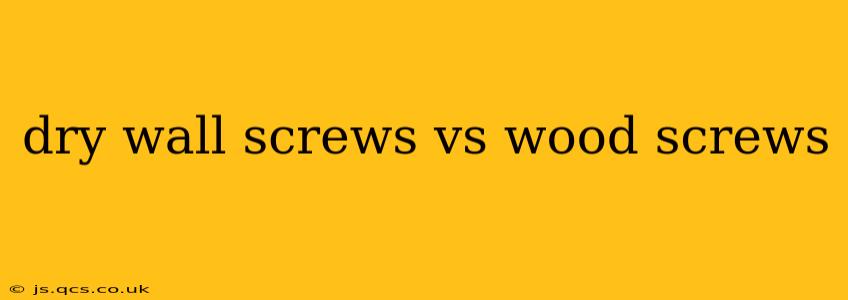Choosing the right screw for your project can significantly impact the outcome. While both drywall screws and wood screws are used for fastening, understanding their key differences is crucial for achieving strong, long-lasting results. This comprehensive guide will delve into the specifics of each, helping you make informed decisions for your next DIY or professional project.
What are Drywall Screws?
Drywall screws, also known as sheetrock screws, are specifically designed for attaching drywall (sheetrock) to framing. They feature a sharp, self-tapping point that easily penetrates drywall without pre-drilling, and a relatively fine thread that creates a secure hold. Their heads are typically smaller and have a lower profile than wood screws, minimizing the need for excessive countersinking.
Key Characteristics of Drywall Screws:
- Sharp, Self-Tapping Point: Facilitates easy penetration of drywall.
- Fine Thread: Provides strong holding power within the drywall material.
- Smaller Head Diameter: Creates a less prominent screw head after installation.
- Often Phosphate-Coated: Enhances corrosion resistance.
What are Wood Screws?
Wood screws, in contrast, are designed for a wide range of applications involving wood. They have coarser threads than drywall screws, creating more aggressive bite into the wood. This allows them to hold significantly heavier loads than drywall screws. They also come in a wider variety of lengths, diameters, and head types.
Key Characteristics of Wood Screws:
- Coarse Thread: Provides better grip and holding power in wood.
- Various Head Types: Including flat, pan, oval, and countersunk heads to suit different applications.
- Wide Range of Sizes: Available in various lengths and diameters to accommodate different wood types and thicknesses.
- Different Materials: Often made from steel, brass, or stainless steel, depending on the intended application.
Drywall Screws vs. Wood Screws: A Detailed Comparison Table
| Feature | Drywall Screws | Wood Screws |
|---|---|---|
| Thread | Fine | Coarse |
| Point | Sharp, self-tapping | Various (sharp, blunt, etc.) |
| Head Type | Typically small, low-profile | Wide variety (flat, pan, oval, countersunk, etc.) |
| Material | Usually steel, often phosphate-coated | Steel, brass, stainless steel, etc. |
| Application | Attaching drywall to framing | Joining wood pieces, fastening to wood, etc. |
| Holding Power | Suitable for lightweight applications | Suitable for heavier loads and structural use |
| Pre-Drilling | Usually not required | Often required, especially in harder woods |
Can You Use Drywall Screws in Wood?
While you can use drywall screws in wood, it’s generally not recommended, especially for heavier applications. The fine threads may not provide sufficient grip, leading to the screw stripping out or pulling loose over time. For wood projects, always opt for appropriately sized wood screws.
Can You Use Wood Screws in Drywall?
Using wood screws in drywall is also usually a bad idea. The coarse threads are too aggressive and can tear the drywall, making the joint weaker. The larger head size might also create unsightly bulges. Drywall screws are purpose-designed for this specific material.
What Type of Screw Should I Use for...?
This depends entirely on the project. If you are hanging pictures or installing shelving on a drywall wall, consider using appropriate drywall anchors rather than trying to screw directly into the drywall. Use wood screws only if securing into a wooden stud. If you are working with drywall itself, always use drywall screws. If working with wood, always use wood screws.
How to Choose the Right Screw Length?
The screw length should be long enough to penetrate sufficiently into the structural member (stud, joist, etc.). For drywall, it should be long enough to penetrate the framing by at least half an inch. For wood, it depends on the thickness of the wood pieces being joined. Always consult manufacturer recommendations for specific applications.
By understanding the key distinctions between drywall and wood screws, you can ensure your projects are completed efficiently and safely, yielding results that are both visually appealing and structurally sound. Remember to always select the correct screw for the specific material and application.
